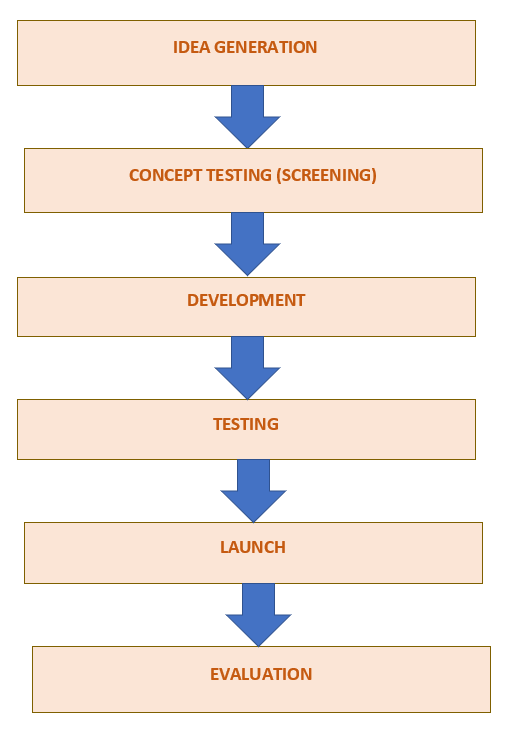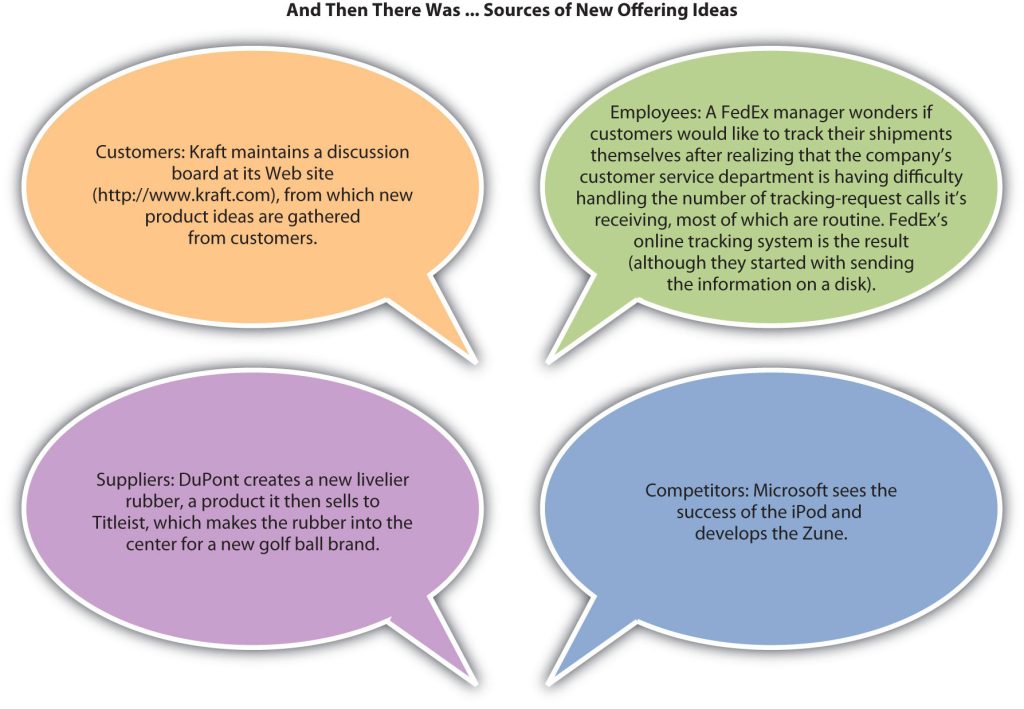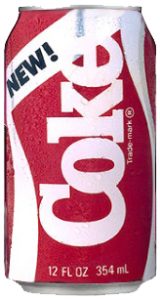7.4 New Product Development Process
Importance of New Products
New products are the life blood of organizations. As competition improves their offerings, new advances are made, trends change, and target market desires fluctuate, companies need to be ready to meet the new demand effectively. This means companies need to have a variety of new products in various stages of the new product development process so they can be proactive in meeting changing demands.
It is important to note that a ‘new’ product includes modifications to existing products.
Most new offerings go through similar stages in their development process. Although the size of a company will affect how the different stages of their new product development process are conducted and whether products are test marketed before being introduced, the steps are generally the same. Figure 7.4.1 “The New Offering Development Process” summarizes these steps. The six steps are listed and described below the graphic.
Figure 7.4.1: The New Offering Development Process

Idea Generation
Many companies, HP and Apple included, were launched in someone’s garage after the founders got an idea for a product and then tried to make and sell it. HP’s first product was an audio oscillator that two Stanford University students developed. Apple’s Macintosh microcomputer was a low-cost knockoff of the Xerox Star, a software-equipped workstation. Apple’s cofounder, Steve Jobs, saw the product demonstrated at a Xerox research center and Xerox was an early investor in Apple (Fisher, 1989).

Ideas can come from anywhere. A Motorola employee came up with an idea for a new cell phone while rollerblading. His idea was to use the wheels of the roller blades to generate electricity to charge a cell phone or MP3 player.
brownpau – Goodbye, old rollerblades – CC BY 2.0.
Employees often come up with new product ideas, too. At Motorola, engineers are working on a mobile phone that can be recharged by rubbing it on smooth surface. A Motorola engineer came up with the idea while rollerblading. He wondered if a small generator could be created to capture and store the energy generated by rollerblade wheels. This idea, in turn, led to the development of a small roller ball (like you would find on an old-style computer mouse) built into the mobile phone. To power up the phone, you just give it a roll.
Ideas can come from anywhere, including your customers. In fact, in business-to-business (B2B) markets, customers are probably the biggest source of new product ideas. Customers know what customers need and want, which provides organizations an indication of market needs. Customers who are good at generating new product ideas or applications of products are called lead users. These people are often courted by manufacturers for this purpose. Lead users exist in consumer markets, too. JCPenney, for example, utilizes a panel of women who help develop and improve the company’s Ambrielle line of lingerie products.
Customers are particularly important cocreators of offerings when they are consuming products with service components. For example, if you provide your hairdresser with feedback while your hair is being cut, your input will alter the final style you receive. Similarly, a businessperson who provides her certified public accountant (CPA) with information and feedback about her firm will help the CPA develop better financial and tax plans for her business.
Suppliers provide another source of ideas for new products. A supplier might develop a new product or technology that can be used to make yet another product, and then go to the makers of those products and suggest new versions of them. For example, McClancy Seasoning Co. makes spices that restaurants and food processing companies use in their food products. (for more information, visit http://www.mcclancy.com/about.
Of course, companies also watch their competitors to see what they’re doing. Some offerings are protected by patents or copyrights and can’t be legally duplicated. The software that runs Apple’s iPhone is an example. There are, however, different ways to achieve the same results as Apple has with its iPhone. The Droid, manufactured by Motorola, and the G5, a copy of the Google phone, are devices similar to the iPhone that operate with software serving the same purpose.
Figure 7.4.2 “New Offering Ideas” shows some product ideas that came from each of the sources we have discussed—employees, customers, suppliers, and one’s competitors. Innovations like the iPhone are rare. However, many new ideas (and consequently new products) aren’t actually new but rather are versions of products and services already available. A line extension occurs when a company comes out with another model (related product) based on the same platform and brand as one of its other products. When Apple added the Nano and the Shuffle to its iPod line, these were line extensions.
Figure 7.4.2: New Offering Ideas

Description of image: “Customers: Kraft maintains a discussion board on its website (http://www.kraft.com), from which new product ideas are gathered from customers. Employees: A FedEx manager wonders if customers would like to track their shipments themselves after realizing that the company’s customer service department is having difficulty handling the number of tracking-request calls it’s receiving, most of which are routine. FedEx’s online tracking system is the result (although they started with sending the information on a disk). Suppliers: DuPont creates a new livelier rubber, a product it then sells to Titleist, which makes the rubber into the center for a new golf ball brand. Competitors: Microsoft sees the success of the iPod and develops the Zune.”
Keep in mind that idea generation is typically the least expensive step in the process of developing a new offering, whether you involve customers or not. As you move through the product development process, each step is usually more expensive than the last. Ideas for new products are relatively cheap and easy to generate; what is difficult and expensive is making them a reality.
Idea Screening / Concept Testing
Not all new product ideas are good ones. Famous product blunders include Ford Motor Company’s Edsel, Clear Pepsi, and Coca-Cola’s New Coke. Less famous is Dell’s cell phone for aging baby boomers. The phone’s large size, large buttons, and large screen screamed “I’m old and blind!” leading potential users to shun it in droves. Yes, even the big companies make mistakes.

Better idea screening might have helped Coca-Cola avoid the problems it encountered marketing its “New Coke” formula.
Wikimedia Commons – New Coke can – public domain.
The purpose of idea screening is to try to avoid mistakes early in the development process. The sooner bad ideas are discarded, the less the investment made and lost. In the idea screening stage, the company tries to evaluate the new offering by answering these questions:
- Does the proposed product add value for the customer? Does it satisfy a market need?
- Can the product be made within a stated time period to get it to market when needed?
- How many units of it will sell and at what price?
- Can we manufacture and sell the product within budget and still make money?
- Do we need to provide the customer with after-sales service? If so, do we have the resources to do that?
- Does the product fit our image and corporate strategy?
Some organizations conduct concept testing at this stage. Concept testing involves running the idea of the offering by potential consumers. The purpose is to get early consumer feedback before investing too much money in an offering that won’t work. Some of the methods used to test concepts include focus groups, in which groups of eight to twelve consumers gather and react to the concept, and depth interviews, in which individuals are presented with the concept and can react to it individually. Focus groups and depth interviews are research techniques that can also be used later in the offering development process to test ideas, or for other purposes. Focus groups working virtually on the Web and by phone actually helped to develop this textbook. Concepts may also be tested online by creating an image and having people representative of the target market provide feedback. Whether using focus groups, depth interviewing, or online methods, concepts must be evaluated by people representative of the target market or the feedback is not relevant.
Because screening considers the feasibility of actually making and servicing an offering, price and cost are important components. If the company cannot sell the product in sufficient quantities to generate a profit, the idea must be scrapped. Understanding the customer’s personal value equation (defined elsewhere as value being equal to benefits received minus the cost, which includes the time and effort of shopping and using) is an important consideration, too. If the value consumers receive from the product is less than the price the company charges for it, they will not buy it. In other words, the offering must be financially feasible to justify investing in it.
The offering must also have process feasibility. Process feasibility is the degree to which the company can actually make and service the product. Process feasibility affects financial feasibility. If the product’s costs cannot be controlled when it’s being made or serviced, the firm’s financial goals won’t be met. Process feasibility also affects customer satisfaction. For example, many manufacturers make great-looking faucets, yet people had to have the “guts” of one faucet replaced three times before it would work, only to find the same experience with the same model was had my many customers. A great-looking design is really only great if it works right.
The question of strategic fit is a difficult one. The history of business is rife with examples of companies failing to develop winning new products only to see their competitors do so. For example, when the inventor Chester Carlson approached IBM executives with the idea of photocopying—the technology platform that later became the heart of Xerox Corporation—they turned Carlson down. IBM did not see the product fitting with its strategy and stopped before they fully considered the potential. Nor did IBM see the moneymaking opportunity the product presented.

A good product doesn’t just look right. It also works right, which is the idea behind process feasibility.
Eric Norris – Faucet Drip 1 – CC BY 2.0.
At this point in the process, the company begins to assess two types of risk. The first is investment risk, or the possibility that the company will fail to earn the appropriate return on the money and effort (the investment) it puts into the new product. The second is opportunity risk, or the risk that there is a better idea that gets ignored because the firm has invested in the idea at hand. When a company is assessing fit, it is assessing its opportunity risk. When it is assessing feasibility (both financial and process), it is assessing its investment risk. Other risk-related questions include whether or not the offering can be developed on time and within budget. Assessing a product’s feasibility continues throughout the entire new product development process.
Development
The next step involves narrowing down the product’s features. Again, price enters the picture as the company considers which features are important to consumers at different price points. A premium (high-priced) offering is likely to be loaded with extra features. By contrast, a low-priced offering is likely to be a “bare-bones” product with few features.
Quality function deployment (QFD) is a process whereby a company begins with the customer’s desired benefits and then designs an offering that delivers those benefits. The benefits are linked to certain characteristics of the offering, which are then broken down into component-part characteristics. From this list of component parts, the product is designed. Thus, the feature specifications process begins with a strong understanding of what consumers want and need.
HP has developed a number of computer printers using the QFD process. The QFD process has been particularly helpful when it comes to bundling the right features within the HP’s printer line because each printer model can be targeted to specific customer needs. Customers can then purchase the model that best suits their needs and doesn’t have a bunch of features that don’t add value for them.
In the development stage, the actual offering is designed, specifications for it are written, and prototypes of it are developed. It is also during this stage that the firm considers the product’s manufacturing process. For example, when a restaurant is developing a new dish, it must not only taste good; it must also be a dish that can be made in a reasonable amount of time once it’s ordered and prepared at a cost that earns the restaurant a profit. In terms of a manufacturer’s offerings, using the same technology platform as another product (like Apple has done with iPhones) can be very effective and cheaper. Using the same platform also generally makes it easier for a company to train its technicians to service a new product.
This stage is not limited to physical products. Services need to be refined, processes determined, and execution tested.
During the development stage , testing is done to ensure that the product works like it’s supposed to in a variety of different environments—that it meets its specifications, that is. For example, Kraft might launch a new food product that has to work in hot climates, cold climates, high humidity, dry climates, and high altitudes—all conditions that can change how well the product works. Many times, alpha testing is done by having employees use the product and getting their feedback.
The next step is beta testing. During beta testing, actual customers make sure the offering works under real-world conditions. Beta testing not only tests whether the offering works as advertised but also tests the offering’s delivery mechanisms, service processes, and other aspects of marketing the product. This step can be an expensive as customers typically receive the product at a reduced rate. Depending on the product, some companies might find it better to simply launch the product and let the market respond to, or test, it once it is available for purchase.
In B2B settings, beta tests are usually conducted with lead users and preferred customers. The developer of the product needs a strong relationship with these customers because the product might still have bugs that need to be ironed out. If the relationship between the parties is “iffy,” and the product or service needs a significant amount of changes, beta testing could damage the relationship between the two parties and hurt the developer of the product’s sales.
Testing
Simultaneous to testing the offering’s ability to meet its specs, the company is also developing and testing the marketing communication plan that will be used to launch the product. Many companies involve consumer panels or user communities, both for testing the offering and the communication plan. As we mentioned, JCPenney solicits the advice of a user community for its Ambrielle line of lingerie. The company frequently runs concepts by the group as well as sends actual prototypes to users to try on and report back to the company. Similarly, the data warehousing company Teradata has a “partners” organization that consists of a community of users who participate in the firm’s product design and testing.
Some companies test the complete launch of a product’s marketing plan to ensure that it reaches buyers, gets positive feedback, and generates sales of the product or service. This is called a market test. Companies may conduct market tests in limited markets or nationwide. For example, when one beverage maker tested the marketing plan for a new wine cooler, the firm first launched the product on the east coast, where the beverage was promoted as a “Polynesian” drink; on the west coast, the beverage was promoted as an “Australian” drink. The Polynesian version proved more popular, so in other new markets, that’s how the beverage was advertised and packaged. This allows the product and the strategy to be tested with actual customers in a limited geographic area. Ideally, the customers do not know this is a market test thus ensuring a realistic response that can be compared to forecasts.
Launch or Commercialization
Once an offering has been designed and tested, it is made available to customers. Sometimes a company launches the offering to all of its markets at once. Other companies may use a rolling launch in which the offering is made available to certain markets first and then other markets later. A rolling launch might make sense if the company’s service technicians need training. The company makes the offering available to one market after the first batch of its employees are prepared to service the product; then as new batches of employees are prepared to service the product, the company enters more markets. While this stage is the ‘goal’ of the entire process, it is the most expensive – thus the riskiest – stage. Ensuring the proper attention to detail and time is devoted to each of the previous stages will limit the risk.
Evaluation
Once an offering is launched, a firm’s executives carefully monitor its progress. Two specific areas are monitored: the product and its progress, and the new product development process itself.
You have probably heard about the “box office” sales for new movies the first weekend following their release. The first weekend is a good predictor of how much money a movie will make overall. If the ticket sales for it are high during the first weekend, a studio’s executives might decide to beef up the promotions for it. If the ticket sales for the movie are low, the studio might stop screening the movie in theaters altogether and release it on DVD instead. For other types of offerings, important milestones might be the first ninety days after the product is launched, followed by a second period of ninety days, and so forth. However, be aware that firms are constantly in the process of evaluating their offerings and modifying them by either adding or subtracting the features and services associated with them, changing their prices, or how they are marketed. The length of time for milestones used to evaluate products may vary depending on the organization and other products or services being developed.
No matter how successful, or not successful, a product launch may be, a thorough debrief of the process should be conducted. Where could better efficiencies been utilized? where could time have been saved? what things were not considered? Constantly looking for ways to improve processes is the hallmark of any successful firm.
You Try It!

